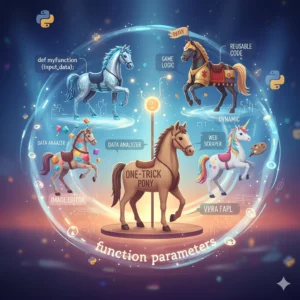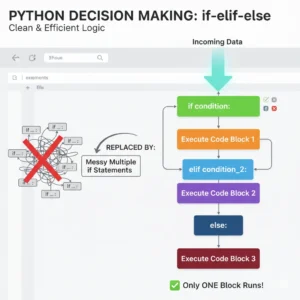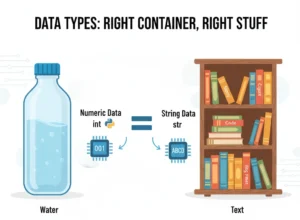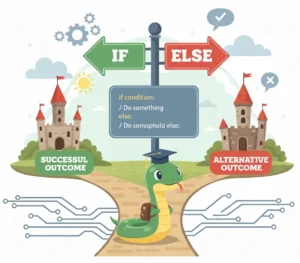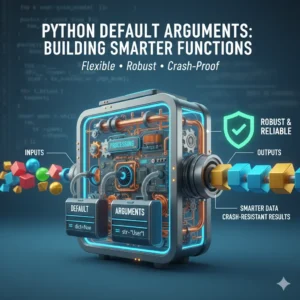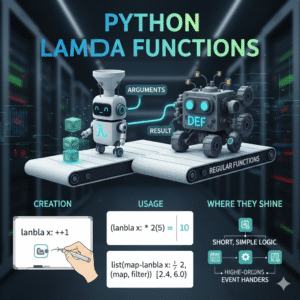Do you find yourself writing the same code over and over to handle each item in a list or each character in a string? If you’ve learned about while loops, you know they can handle repetition, but they can feel clunky for tasks that involve stepping through a collection of items. What if Python had a more intuitive way to loop through these “sequences”?
This post is your answer. We’re diving into the Python for loop, a powerful tool that makes iterating over sequences like strings, lists, and more incredibly straightforward. By the end of this guide, you’ll be able to automate repetitive tasks with clean, efficient, and readable code. Let’s unlock the power of iteration!
What is a Python For Loop?
A Python for loop is used to iterate over a sequence (like a string, list, tuple, or dictionary) and execute a block of code for each item in that sequence.
Think of it like this: if you have a basket of fruits (a list), a for loop lets you pick up each fruit one by one and do something with it—like print its name—without having to manually write a line of code for each apple, orange, and banana.
The key difference from a while loop is its foundation:
- While Loop: Runs while a condition is true.
- For Loop: Runs for each item in a sequence.
Understanding the For Loop Syntax
The syntax of a for loop is clean and readable. Here’s the basic structure:
for variable in sequence:
# Code to execute for each itemLet’s break this down:
for: This is the keyword that starts the loop.variable: This is a temporary variable you create. On each iteration of the loop, it will hold the current item from the sequence.in: This is the membership operator that connects your variable to the sequence.sequence: This is the collection of items you want to loop over.- The colon
:and indentation are crucial—they tell Python which code is inside the loop.
Your First For Loop in Action
The best way to understand is to see it in code. Let’s start with the simplest sequence: a string.
Looping Through a String
In Python, a string is a sequence of characters. Let’s loop through one.
# Define a string (our sequence)
message = "Hello, we are learning Python."
# Create the for loop
for character in message:
print(character)Output:
H
e
l
l
o
,
w
e
a
r
e
...What’s happening here?
- We define a string variable called
message. - The
forloop starts:for character in message:. - In the first iteration, the variable
characteris assigned the value'H', the first character in the string. The code inside the loop (print(character)) runs, printingH. - The loop then goes back to the top.
characteris now assigned the next value,'e', and it gets printed. - This process repeats for every single character in the string, including spaces and punctuation, until the sequence is exhausted.
Looping Through a List
Lists are another very common sequence used with for loops. Let’s see how it works.
# Define a list (our sequence)
grocery_list = ["fruits", "soap", "utensil"]
# Create the for loop
for item in grocery_list:
print(item)Output:
fruits
soap
utensilThe logic is identical to the string example. The loop automatically assigns the variable item to each element in the list, one after the other, and executes the print statement. This is far more efficient than manually writing print(grocery_list[0]), print(grocery_list[1]), etc.
Building Meaningful Programs With For Loops
Printing items is a great demo, but let’s use for loops to solve actual problems.
Example 1: Counting Characters in a String
What if you wanted to know how many characters are in a string? You can use a for loop to count them.
message = "Hello"
count = 0 # Initialize a counter variable
for char in message:
count += 1 # This is the same as count = count + 1
print("Total number of characters:", count)Output:
Total number of characters: 5How it works:
- We start with
countset to0. - The loop runs for each character in
"Hello"(5 times). - On each loop, the code
count += 1increases the value ofcountby 1. - After looping through all 5 characters,
countis 5, and we print the result.
Example 2: Counting Specific Items (Vowels)
Let’s make it more complex. We’ll count how many vowels are in a string.
message = "Hello, this is a lovely day."
vowels = "aeiou" # Define what counts as a vowel
vowel_count = 0
for char in message:
# Check if the current character is a vowel
if char in vowels:
vowel_count += 1
print("Total number of vowels:", vowel_count)Output:
Total number of vowels: 8How it works:
- We define our sequence (
message) and what we’re looking for (vowels). - The loop goes through each
charinmessage. - Inside the loop, we use a membership operator (
in) to check: “Is the currentcharpresent in thevowelsstring?” - If the condition is
True(e.g., whencharis'e'), we increase thevowel_count. - If it’s
False(e.g., whencharis'H'), theifblock is skipped, and the loop continues. - This is a powerful pattern: using a
forloop with a conditional statement to filter and process data.
Note: The above example only checks for lowercase vowels. To also count uppercase vowels (
A,E,I,O,U), you could change thevowelsstring to"aeiouAEIOU".
Ready to Go from Basics to Pro?
You’ve just taken a major step in your Python journey by mastering the for loop. These examples show the foundation, but there’s a whole world of loop control (like break and continue), nested loops, and iterating over more complex data structures like dictionaries. If you try to learn these piecemeal, it’s easy to get lost or develop gaps in your knowledge.
A structured course can take you from understanding basics to building real-world projects with expert guidance and a clear learning path. You’ll gain the confidence to tackle any coding challenge that comes your way.
If you’re serious about mastering Python, check out our pre-recorded python comprehensive video course.
Conclusion
The Python for loop is an essential tool for automating repetitive tasks and working with sequences. You learned the clean syntax, how to iterate through strings and lists, and how to build practical programs like character and vowel counters. The key is to remember that the loop variable takes on the value of each item in your sequence, allowing you to operate on them one by one.
Keep practicing by writing your own loops. Try to count consonants in a string, find the largest number in a list, or print a pattern. The more you code, the more natural it will feel!
Common Questions About Python For Loops
What’s the main difference between a for loop and a while loop?
A for loop is used for iterating over a known sequence (like a list or string), while a while loop repeats as long as a specific condition is true. Use a for loop when you know how many times you need to iterate; use a while loop when you don’t.
Can I use a for loop with numbers (e.g., from 1 to 10)?
Yes! While this guide focused on sequences, you can use the range() function (e.g., for i in range(10):) to generate a sequence of numbers to loop over. The range() function is a common partner for for loops.
What happens if I change the sequence inside the for loop?
It’s generally not recommended as it can lead to confusing behavior and errors. It’s best practice to avoid modifying the sequence you are iterating over.





